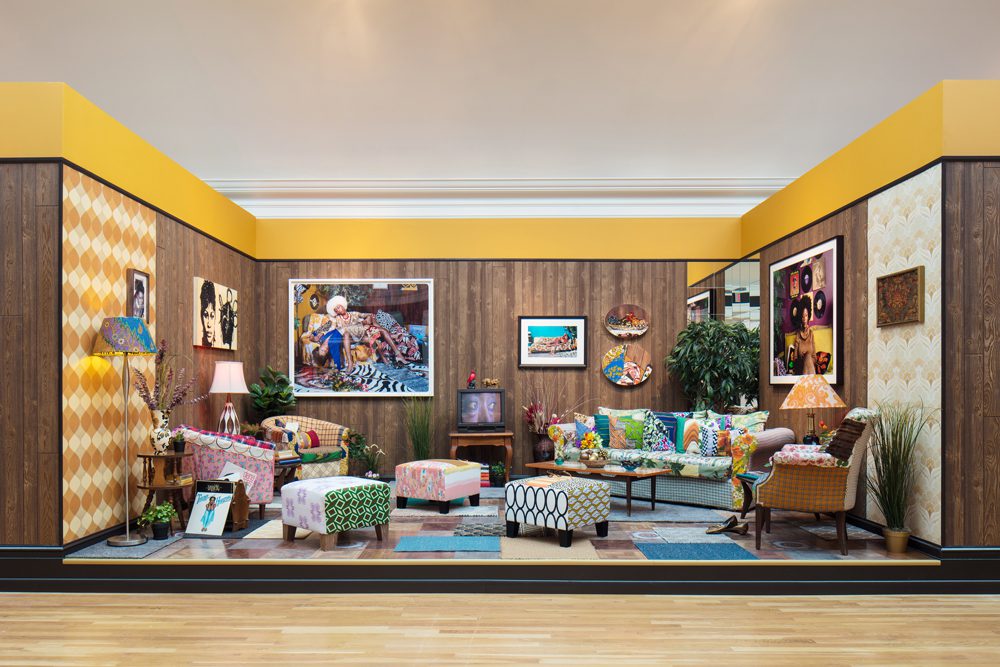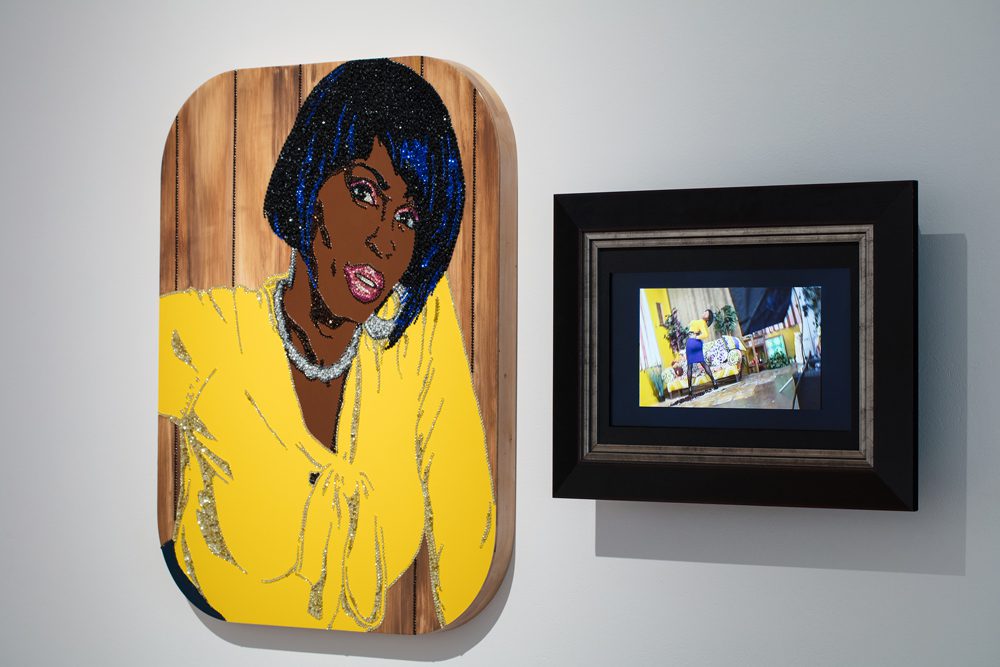I Want To Be Daring: Mickalene Thomas at Newcomb Art Museum
Charlie Tatum looks at how Mickalene Thomas riffs on art history to let black women determine how their bodies are presented.

Mickalene Thomas, Shinique: Now I Know, 2015. Rhinestones, acrylic, and oil on wood panel. Courtesy the artist and Galerie Nathalie Obadia, Paris and Brussels.
Mickalene Thomas’ paintings are flashy. The artist is best known for her luscious portraits of black women posed amongst luxurious floral patterns and printed fabrics, all rendered in vividly colored rhinestones and paint on panel. Thomas’ subjects are women often from her life—friends, lovers, and most notably her mother—dressed in wigs, stilettos, and glimmering jewelry. These women, and the very act of portraying them as strong, monumental figures, are at the center of Thomas’ practice.
Portraiture has existed since ancient times, and art history pops up throughout Thomas’ works. Reclining figures bear the smalls of their backs as Ingres-inspired odalisques. In one of Thomas’ most famous images, three women pose as Édouard Manet’s picnickers. And in another work, the artist replaces Gustave Courbet’s L’Origine du monde, 1866, with the figure of a black woman, her pubic hair made of dark glistening rhinestones. In Thomas’ current exhibition, “Waiting on a Prime-Time Star,” at Newcomb Art Museum of Tulane University, even the exhibition’s title playfully riffs on Colored TV, 1977, a painting by Robert Colescott, who famously created satirical renderings of works by Manet, Vincent van Gogh, and Jan van Eyck, inserting black figures into the whiteness of the art historical canon.
But Thomas’ paintings aren’t a simple reversal, an approach that’s been taken by artists including Kehinde Wiley, the New Orleans-based duo E2, and countless graduate students recently introduced to the politics of representation; Thomas is instead interested in the ways history is built on both grand and personal scales. In Le Jardin d’Eau de Monet, 2012, which was started during a residency at the Impressionist artist’s estate in Giverny, France, Thomas depicts the landscape in a haphazard collection of fragmented views, seemingly drawing from a different artist in each section of the panel—van Gogh’s impasto trees in the distance, Andy Warhol’s starkly outlined flowers, and Henri Matisse’s flattened planes of color. Thomas has noted that she started using her signature rhinestones because of her interest in Pointillism. And with every glance back at art history—a canon built around whiteness and Eurocentrism—Thomas also comments on the influences that propelled these masters’ innovations, often inspired by their exoticization of Africa, the Middle East, and Asia.

Installation view of Mickalene Thomas’ Waiting on a Prime-Time Star, 2017, at Newcomb Art Museum of Tulane University, New Orleans. Furniture, photographs, fake plants, paintings, faux wood paneling, carpet, and pillows. Courtesy the artist and Artists Rights Society. Photo by Jeffery Johnston.
In an overcrowded talk on the night of the exhibition’s opening at Tulane, the artist explained that, despite her distinctive style, her portraits are 80 percent reflective of the personalities and desires of the sitters. (She said her own direction and the camera account for the remaining 20 percent. Although Thomas considers herself principally a painter, most of her works begin with photography.) This leaves a serious question—one that was pushed aside as art history embraced the vision of artistic genius over patronage: Can a portrait be primarily about the sitter and not the painter whose eyes it’s filtered through? Thomas attempts to reckon with this question, balancing her own artistic creation with the desires of those she portrays.
Thomas’ unique consideration of her subjects began with her mother, Sandra Bush, whom she first photographed as a graduate student, prompted by her professor David Hilliard’s assignment to use photography to ameliorate a difficult relationship. Through these trying and therapeutic sessions, Thomas allowed herself to begin to understand her mother through both the conceptual distance of her camera and the intimacy of their on-set conversations. Stepping back and reapproaching their relationship from the position of an artist in addition to that of a daughter allowed her to see strength, humor, and softness in her mother, and Thomas hopes that her time with all of her sitters allows their personalities to shine through.

Installation view of Mickalene Thomas’ Ain’t I A Woman (Keri), 2009, at Newcomb Art Museum of Tulane University, New Orleans. Rhinestones, acrylic, and enamel on wood panel and DVD and framed monitor. Courtesy the artist and Artists Rights Society.
While the oversized panels and her models’ fierce stances are evidence enough of self-possession, Thomas complicates the fixity of identity by occasionally including videos alongside her paintings. Ain’t I A Woman (Keri), 2009, pairs Thomas’ finished portrait with a behind-the-scenes video of the titular figure bending over, curving her back, and pouting her lips while Eartha Kitt’s “I Want to Be Evil” plays in the background. Some of these poses are awkward and unflattering, but Thomas includes this footage to highlight the vulnerability and performance inherent in presenting oneself—or depicting someone else. Also on view is Happy Birthday to a Beautiful Woman (2012), Thomas’ first short film, which presents footage of her mother reflecting on her struggles with drug addiction, abusive relationships, and the fashion industry. Bush had dreams of becoming a supermodel in the 1970s that never came to bear, but she eventually found her stardom as a repeated subject of Thomas’ paintings and photographs.
Happy Birthday is the centerpiece to a living-room-sized installation in the museum, an immersive set with paneled walls, block-print fabrics, mid-century furniture, and books by Octavia Butler, Toni Morrison, and W.E.B. Du Bois. Thomas’ installation, which includes several photographs and paintings, is a recreation of the backdrops she uses for her models, evoking the vibrancy of pop culture in the Soul Train era and replicating the artist’s own childhood memories. This space is emphatically black and female—explicitly created for homosocial relationships between women of color in order for them to feel agency over their own likenesses. And this literal and metaphoric space seems to be the real subject of Thomas’ work, which asks us not just to imagine an alternative art history filled with faces of color but also to envision the equitable creation of black masterpieces now and in years to come.
Editor's Note
Mickalene Thomas’ “Waiting on a Prime-Time Star” is on view through April 9, 2017, at Newcomb Art Museum of Tulane University in New Orleans.



